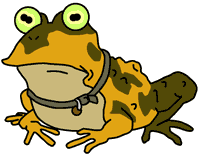Hypnosis and Genetics
 "No, no, no, don't try any of that cow hypnosis on me, all right? It's not gonna work!"
"No, no, no, don't try any of that cow hypnosis on me, all right? It's not gonna work!"--Train Conductor
SOUTH PARK (Season 1)
First up on the hypnosis hit parade is the article by Raz et al. (in press). The last author, Mike Posner, is a prominent cognitive psychologist who has studied the cognitive and neural mechanisms of attention for over 40 years.
Amir Raz, Jin Fan and Michael I. Posner (in press). Neuroimaging and genetic associations of attentional and hypnotic processes. Journal of Physiology (Paris).
The authors begin by reviewing their work on attention, and suggest this psychological construct should be considered an "organ system" with a distinctive brain anatomy from other perceptual and cognitive functions. They discuss 3 component attentional systems that occupy separate neural networks: orienting, alerting, and executive control. Furthermore, they propose that each of these networks is pharmacologically distinct:
"cholinergic systems arising in the basal forebrain play an important role in orienting; the norepinephrine (NE) system arising in the locus coeruleus of the midbrain is involved in alerting; and the anterior cingulate cortex (ACC) and lateral prefrontal cortex are target areas of the mesocortical dopamine system -- involved in executive attention."It sounds nice, but it's hard to imagine the "one attentional system, one neurotransmitter" mapping is correct.
So how does all of this relate to hypnosis?
"...evidence relating hypnotic phenomena to attentional mechanisms is mounting (Raz et al., 2002b) and there is general accord that hypnotic phenomena implicate attention (Karlin, 1979) and relate to self-regulation (Posner and Rothbart, 1998)."I guess we'll have to take their word for it (or else read the cited references). At any rate, the major intersection between attention and hypnosis in the research realm has been elimination of the well-known Stroop interference effect in highly hypnotizable people who are under a specific post-hypnotic suggestion to avoid reading the words (Raz et al., 2002b, 2003, 2005, 2006), which is usually considered a pretty darn automatic process.
Just to quickly demonstrate the Stroop, name the font color of the words below (don't read the words).
RED
People are reliably slower for the second.

!_#($+(@
Old data from the 70's (Morgan et al.) suggested that hypnotizability in monozygotic twins shows a correlation of 0.52-0.63, but only 0.08-0.18 for dizygotic twins. Since Raz, Fan, and Posner subscribe to the "one transmitter, one attentional system" hypothesis, they decided to go after dopaminergic-type genes (since DA is the "executive control" transmitter).
"Drugs known to affect the dopaminergic system as well as alter consciousness (e.g., propofol) seem to induce hypnosis-like experiences and modulate executive attention (DiFlorio, 1993; Fiset et al., 1999; Rainville et al., 2002; Xie et al., 2004)."
COMT (catechol-O-methyltransferase) catalyzes the transfer of a methyl group from S-adenosylmethionine to catecholamines, including the neurotransmitters dopamine, epinephrine, and norepinephrine. This O-methylation results in one of the major degradativeSo basically, COMT is an enzyme that breaks down all catecholemines, not just dopamine. And both DA and NE have effects on prefrontal cortex.
pathways of the catecholamine transmitters.
Arnsten AF, Li BM.Nonetheless, the overall finding on suggestion and Stroop is interesting, even if the genetics at this point are questionable.
Neurobiology of executive functions: catecholamine influences on prefrontal cortical functions.
Biol Psychiatry. 2005 57(11):1377-84. Review.The prefrontal cortex guides behaviors, thoughts, and feelings using representational knowledge, i.e., working memory. These fundamental cognitive abilities subserve the so-called executive functions: the ability to inhibit inappropriate behaviors and thoughts, regulate our attention, monitor our actions, and plan and organize for the future. Neuropsychological and imaging studies indicate that these prefrontal cortex functions are weaker in patients with attention-deficit/hyperactivity disorder and contribute substantially to attention deficit/hyperactivity disorder symptomology. Research in animals indicates that the prefrontal cortex is very sensitive to its neurochemical environment and that small changes in catecholamine modulation of prefrontal cortex cells can have profound effects on the ability of the prefrontal cortex to guide behavior. Optimal levels of norepinephrine acting at postsynaptic α-2A-adrenoceptors and dopamine acting at D1 receptors are essential to prefrontal cortex function. Blockade of norepinephrine α-2-adrenoceptors in prefrontal cortex markedly impairs prefrontal cortex function and mimics most of the symptoms of attention-deficit/hyperactivity disorder, including impulsivity and locomotor hyperactivity. Conversely, stimulation of α-2-adrenoceptors in prefrontal cortex strengthens prefrontal cortex regulation of behavior and reduces distractibility. Most effective treatments for attention-deficit/hyperactivity disorder facilitate catecholamine transmission and likely have their therapeutic actions by optimizing catecholamine actions in prefrontal cortex.
- Hypnosis And Consciousness
Next in a continuing series on hypnosis: Functional neuroanatomy of the hypnotic state In Press, Corrected Proof, Journal of Physiology (Paris). Marie-Elisabeth Faymonville, Mélanie Boly and Steven Laureys What is hypnosis and how to induce it There...
- Webcast By Dr. Daniel Weinberger About Comt, Prefrontal Lobe, And Executive Function
According to an NIH press release, Dr. Daniel Weinberger will be speaking tomorrow on a live webcast on the topic, Complex Genetics in the Human Brain: Lessons from COMT, tomorrow from 3:00-4:00 p.m. ET at http://videocast.nih.gov. The talk...
- Sarcasm And The Brain: Look At The Right Prefrontal Cortex
From The APA Monitor:It's no joke: Study identifies brain circuitry involved in our grasp of sarcasm The APA Monitor May 2005 Print version: page 13 A study in May's Neuropsychology (Vol. 19, No. 2) finds the right prefrontal cortex--a brain...
- In The Weeklies
Here are some relevant highlights from this week’s major scientific and medical weeklies: New England Journal of Medicine 28 October 2004 This week’s issue includes several papers of interest, two on the topic on bacterial meningitis and the...
- This Is Your Brain Under Hypnosis
Today’s New York Times reports that hypnosis may, in fact, change perception in the brain. Sandra Blakeslee reports on a study which supports this. Dr. Amir Raz demonstrated that the Stroop effect was “obliterated” in the “highly hypnotizable...
